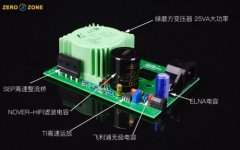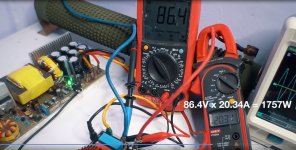The title seems a bit negative and it's meant to be. I'd like someone to clue me in why switching power supplies are better in any aspect OTHER than being cheap.
I have a first-generation Squeezebox that burned up the OEM wallwart in 3 years due to the always-on fluorescent display taking a fair bit of current 24/7. I replaced it with a higher-spec'd wallwart that lasted 1 year (probably bogus specs--bought it on eBay from China). Then a much larger inline one was tried and also failed in less than a year. These are all 5V supplies, BTW.
Finally I bought a ~$50 linear PS off eBay (again China) that is very pretty inside & out. It doesn't run warm like the switchers did. It's been flawless for over 2 years. Yes I know that isn't proof of anything but it doesn't change the fact that all the switchers failed when used below their rating.
I have a first-generation Squeezebox that burned up the OEM wallwart in 3 years due to the always-on fluorescent display taking a fair bit of current 24/7. I replaced it with a higher-spec'd wallwart that lasted 1 year (probably bogus specs--bought it on eBay from China). Then a much larger inline one was tried and also failed in less than a year. These are all 5V supplies, BTW.
Finally I bought a ~$50 linear PS off eBay (again China) that is very pretty inside & out. It doesn't run warm like the switchers did. It's been flawless for over 2 years. Yes I know that isn't proof of anything but it doesn't change the fact that all the switchers failed when used below their rating.
Attachments
SMPU's in general performs better than any other linear PSU. Imagine, for example, PC's. Do you imagine the cost, and the size of a linear PSU for a simple AMD486, for example. Also, as their main advantage is its low size and higher characteristics, they always fail in the primary side protecting the load, linear PSU's of the series type fails always destroying its load, unless shunt regulators are used. Take into account, also, long service of industrial PSU's of the switching type, many of them 24/7 during several years. I'm ever in favor of SMPS over their linear counterparts.
It doesn't run warm like the switchers did.
That might be a crucial clue to what's going on. Maybe for the money of several borderline cheap supplies a single decent one would have been the ticket?
I have been running my home network (modem, wifi access point, NAS, phone) off the same switchmode supply for at least 10, probably 15 years. 24/7. The only part of that installation that has never changed is that power supply that I bought used back in the day...
SMPS is the efficient way to generate reliable and accurate power, that is why they are so good. Don't but fleabay stuff as they will fail.
Efficiencies of over 90% typical with good design, appropriate sizing and choice of technology for the application.
Compact and lightweight, at high power levels this can be rather important.
The noise can be managed with careful design and some thought to filtering and shielding.
Compact and lightweight, at high power levels this can be rather important.
The noise can be managed with careful design and some thought to filtering and shielding.
It all boils down to switching transistor operating efficiency and reliability. There have been great strides in the development of switching MOSFETs with on resistances approaching that of a piece of wire. Some medium sized switching MOSFETs can deal with a current of over 100A. MOSFETs have evolved vastly.
Last edited:
They take flak because historically they weren't quiet or more accurately where quiet in the region where linear regs were most effective tive. That's not true these days, though implementation is everything.
I'm a big fan of SMPS especially for things non audio. I think of all those heavy, bulky wall-warts that have been replaced with small, light SMPS types. We used to run out of power strip space backstage with all those big lumps. Now many of them take up no more space that the width of the puny Edison plugs we use here in the USA. Laptop PSUs have also shrink in size and weight. Love 'em.
The title seems a bit negative and it's meant to be. I'd like someone to clue me in why switching power supplies are better in any aspect OTHER than being cheap.
I have a first-generation Squeezebox that burned up the OEM wallwart in 3 years due to the always-on fluorescent display taking a fair bit of current 24/7. I replaced it with a higher-spec'd wallwart that lasted 1 year (probably bogus specs--bought it on eBay from China). Then a much larger inline one was tried and also failed in less than a year. These are all 5V supplies, BTW.
Finally I bought a ~$50 linear PS off eBay (again China) that is very pretty inside & out. It doesn't run warm like the switchers did. It's been flawless for over 2 years. Yes I know that isn't proof of anything but it doesn't change the fact that all the switchers failed when used below their rating.
Commercial electronics is designed for minimum cost, not long life, alas. A professional SMPS for OEM use will be more expensive, but be engineered for long life. "Automotive qualified" and "professional" are good keywords to find in a datasheet. Oh yes, make sure there's a datasheet. As someone said its all in the implementation, but SMPS totally dominate due to greater efficiency, being input-voltage agnostic, much lighter and smaller, and for a high power supply cheaper to make (due to the high cost of copper in large mains frequency transformers).
Future SMPS will use GaNFETs which can handle higher frequency switching with low loss, meaning smaller transformers and capacitors and even greater efficiency. The higher frequencies put the PSU noise way above the audio band too.
A class-D amplifier board with integral SMPS outputting 1000W of clean power with vanishing distortion at 90% efficiency in a package the size of a six-pack of beer is a beautiful thing!
A class-D amplifier board with integral SMPS outputting 1000W of clean power with vanishing distortion at 90% efficiency in a package the size of a six-pack of beer is a beautiful thing!
I cant confirm from my exeprience as sales Manager for PA Application in +10 years
SMPS dont have long term reliability in PA Amps
SMPS is asking for trouble often fail.... expected lifetime 3 - 5 years
For long time reliabilty a Class D amp with Torodial linear power supply is workhorse without issues
1. have sold hundreds PA Class D Amplifier
many SMPS fail to much........dont ask me
same with PA Class H Amplifier
2. have sold hundreds PA Class AB/H Amplifier
Never 0 Torodial linear power supply fail up today from all sales
output stage sometimes fail .... heat and second breakdown BJT
Last edited:
Benchmark AHB2 power amp uses a high-frequency SMPS. They say they need it in order to get the SOTA amplifier performance. However, at the price of AHB2 they can afford to design a very, very good SMPS for it.
SMPS is the efficient way to generate reliable and accurate power, that is why they are so good. Don't but fleabay stuff as they will fail.
Reliable for High Power in PA Application ? NO NO NO
Reliable for High Power in Inverter Air conditioner ? NO NO NO
most of them about 3 - 5 years old and fail, 2019 have see to much
Costumer decide to buy new product,
because
repair to expensive or
No service manual for technican available
electronic board not stock, ..... 2 - 3 months waiting
technican dont have experience to fix, only can change whole board
Using SMPS means, about 3 to 5 years you need to buy new the whole product
small power level PC/Laptop/TV mobile charger/ consumer electronic
I can confirm, smps very good
The PA application might be distantly related to the issue I had. For continuous high output a switching supply may not survive long.
Like with everything, there will be exceptions. I'm sure there are mil-spec smps out there that could perform into the next century. It'll probably cost more than the device it powers.
Like with everything, there will be exceptions. I'm sure there are mil-spec smps out there that could perform into the next century. It'll probably cost more than the device it powers.
The PA application might be distantly related to the issue I had. For continuous high output a switching supply may not survive long.
I'm sure there are mil-spec smps out there that could perform into the next century. It'll probably cost more than the device it powers.
Yes with MIL ....
I bought 4 SMPS mains adaptors off ebay (Chinese seller) and all failed within a week of using them.
I bought 3 from CPC and none have failed in months of use.
I guess its down to poor design and poor quality why they don't last very long.
I bought 3 from CPC and none have failed in months of use.
I guess its down to poor design and poor quality why they don't last very long.
Benchmark AHB2 power amp uses a high-frequency SMPS. They say they need it in order to get the SOTA amplifier performance. However, at the price of AHB2 they can afford to design a very, very good SMPS for it.
Let us speak true, this Amp is in my eyes toys,
no problem for the internal SMPS to survive.....
But how about like this: 86,4 V AC x 20,34A = 1757 Watt Amplifier output
How long will SMPS survive ?
Lucky for sales when fail after warranty, costumer will buy new amp
Attachments
NMOS,
What is it in your opinion that makes SMPS less reliable than any other electronic device?
Also, why do you think SMPS can work fine for some uses but not for others?
From what you have said so far it seems like you have a lot of bad experience with poorly designed SMPS that were designed for low cost, not for rugged reliability. If so, that doesn't prove that SMPS can't be reliable, only that poorly designed SMPS are not likely to be very good.
What is it in your opinion that makes SMPS less reliable than any other electronic device?
Also, why do you think SMPS can work fine for some uses but not for others?
From what you have said so far it seems like you have a lot of bad experience with poorly designed SMPS that were designed for low cost, not for rugged reliability. If so, that doesn't prove that SMPS can't be reliable, only that poorly designed SMPS are not likely to be very good.
- Home
- Amplifiers
- Power Supplies
- Why do switch-mode PS get any respect at all?

